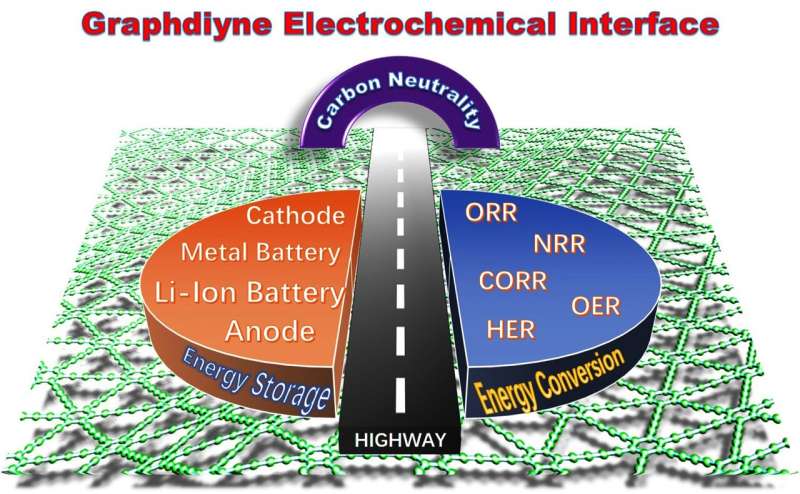2D graphdiyne a potential key element for future generations of energy storage and conversion technologies

A synthetic carbon-based crystalline material called graphdiyne (GDY) has become a probable key element in driving the next significant leap in battery technology—one not seen since lithium surpassed lead and other heavy metals in the early 1990s.
Professor Zicheng Zuo, a member of graphdiyne team in the Chinese Academy of Sciences, Institute of Chemistry, published a review paper on the state of the art in GDY's development and use as an interface component of energy storage and conversion. "Due to the inherent characteristics of GDY, some new phenomena and properties have been discovered in a wide range of research fields," Zuo and his co-researchers wrote in the paper.
"GDY has made substantial breakthroughs in fundamental and applied science, formed innovative scientific concepts and made great achievements."
The review paper was published in Nano Research Energy.
Among GDY's achievements, the authors focused primarily on the 2D crystal's potential as it relates to energy conversion and storage. Amid the global fight to reduce carbon emissions, the scientific community has been pressed to find ways of getting the most out of renewable energy sources, Zuo explained, and better energy storage is a big part of that. Significant improvements in mass energy storage will help maximize the effective yield of solar and wind. The hourly output of each varies greatly depending on weather and time of day.
Graphdiyne is an infinitely scalable crystalline lattice that can hold a charge and offers up little resistance upon discharge, making it an ideal battery anode for a possible next generation of high-tech batteries that would make mass renewable energy reserves viable and electric vehicles accessible to a much wider market.
"Research strongly indicates that the graphdiyne interface has strong potential for mass-market applications of high-energy density batteries and water splitting, which are important fields for creating a sustainable society," Zuo said. "We firmly believe that these materials will bring transformative progress for energy storage and conversion in five to ten years."
Zuo's team examined graphdiyne's potential as an interface between the building blocks of various batteries, such as magnesium, lithium, sodium, and potassium, all of which are being widely studied for uses in future energy storage. The findings across a number of experiments with different energy storage uses showed that graphdiyne is a highly effective conductor of electricity that allows current to pass along a path with little resistance.
Graphdiyne also held up as stable over time, further making it a desirable subject of study for real-world future energy storage applications. "Stability and controllability are two unprecedented advantages of a graphdiyne interface, and it has the potential to revolutionize the interfacial stability and functions in real scenarios," Zuo said.
Since graphdiyne is a crystalline lattice grown in precisely controlled laboratory settings, ways of producing it faster may need to be found to make it viable for commercial industry and public infrastructure-scale applications. Zuo said he and his colleagues will continue to study graphdiyne's potential in energy storage.
"In the future, we will scale up the research and build large-scale prototype devices to show the advantages of the graphdiyne interface in advancing the energy density and lifespan of batteries."
More information: Xiaoya Gao et al, Advanced electrochemical energy storage and conversion on graphdiyne interface, Nano Research Energy (2022). DOI: 10.26599/NRE.2022.9120036
Provided by Tsinghua University




















